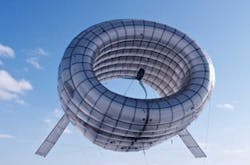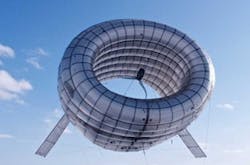Altaeros Develops Commercial Airborne Wind Turbine That Soars Up to 2,000 Feet
Photo Credit: Manufacturing.net
For Altaeros Energies, a start-up launched out of MIT, the sky is the limit when it comes to wind power.
Founded by alumni Ben Glass '08, SM '10 and Adam Rein MBA '10, Altaeros has developed the world's first known commercial airborne wind turbine, also known as the BAT (The Buoyant Air Turbine), which uses a helium-filled shell to float as high as a skyscraper and capture the stronger, steadier winds available at that altitude.
Proven to produce double the energy of similarly sized tower-mounted turbines, the system, is now preparing for commercial deployment in rural Alaska that is set to take place next year. While there, the BAT will test its ability to power microgrids at a site south of Fairbanks, Alaska, in an 18-month trial funded by the Alaska Energy Authority.
People in rural Alaska rely on gas and diesel generators for power, paying upward of $1 per kilowatt-hour for electricity. The BAT, which has a capacity of 30 kilowatts, aims to drop that kilowatt-hour cost down to roughly 18 cents, the co-founders say.
The magic of the turbine begins with its construction.
The turbine was built with a circular, 35-foot-long inflatable shell made of the same heavy-duty fabric used in blimps and sails and can hover between 1,000 to 2,000 feet above ground, where winds blow five to eight times stronger and more consistently than winds at tower level (roughly 100 to 300 feet).
Three tethers connect the BAT to a rotating ground station, automatically adjusting its altitude to obtain the strongest possible winds. Power generated by the turbine travels down one of the tethers to the ground station before being passed along to microgrids.
Glass says the BAT is like a reverse crane.
"A crane has a nice stationary component, and an upper platform that rotates in order to suspend things down," he said. "We're doing the same thing, but suspending things up."
But despite its efficiency, the BAT is not designed to replace conventional tower-mounted turbines, Rein says. Instead, its purpose is to bring wind power to remote, off-grid areas where towers aren't practically or economically feasible.
Read the full article here.
About the Author
Manufacturing.net
Manufacturing.net

Leaders relevant to this article:

